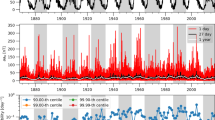Abstract
The cosmogenic radionuclides, 10Be, 14C and others, provide a record of the paleo-cosmic radiation that extends >10,000 years into the past. They are the only quantitative means at our disposal to study the heliosphere prior to the commencement of routine sunspot observations in the 17th century. The cosmogenic radionuclides are primarily produced by secondary neutrons generated by the galactic cosmic radiation, and can be regarded, in a sense, as providing an extrapolation of the neutron monitor era into the past. However, their characteristics are quite different from the man-made neutron monitor in several important respects: (1) they are sensitive to somewhat lower cosmic ray energies; (2) their temporal resolution is ∼1 to 2 years, being determined by the rapidity with which they are sequestered in ice, biological, or other archives; (3) the statistical precision for annual data is very poor (∼19%); however it is quite adequate (∼5% for 22-year averages) to study the large variations (±40%) that have occurred in the paleo-cosmic ray record in the past between grand solar minima and maxima. The data contains “noise” caused by local meteorological effects, and longer-term climate effects, and the use of principal component analysis to separate these “system” effects from production effects is outlined. The concentrations of 10Be decreased by a factor of two at the commencement of Holocene, the present-day “interglacial”, due to a 100% increase in the ice accumulation rates in polar regions. The use of the 10Be flux to study heliospheric properties during the last glacial is discussed briefly.









Similar content being viewed by others
References
S. Baumgartner, J. Beer, J. Masarik, G. Wagner, L. Meynadier, H.A. Synal, Geomagnetic modulation of the Cl-36 flux in the GRIP ice core, Greenland. Science 279(5355), 1330–1332 (1998)
J. Beer, Accelerator mass spectrometry: a new tool in environmental sciences. Nucl. Phys. News 7(2), 15–22 (1997)
J. Beer, K.G. McCracken, J.A. Abreu, U. Heillila, F. Steinhilber, Long-term changes in cosmic rays derived from cosmogenic radionuclides, in Proc. 30th International Cosmic Ray Conference, Merida, Mexico (2007)
J. Beer, K.G. McCracken, R. von Steiger, Cosmogenic Radionuclides: Theory and Applications in the Terrestrial and Space Environments (Springer, Berlin, 2011)
A.M. Berggren, J. Beer, G. Possnert, A. Aldahan, P. Kubik, M. Christl, S.J. Johnsen, J. Abreu, B.M. Vinther, A 600-year annual Be-10 record from the NGRIP ice core, Greenland. Geophys. Res. Lett. 36 (2009)
R.C. Finkel, K. Nishiizumi, Beryllium-10 concentrations in the Greenland ice sheet project 2 ice core from 3–40 ka. J. Geophys. Res. 102(C12), 26699–26706 (1997)
U. Heikkilä, Modeling of the Atmospheric Transport of the Cosmogenic Radionuclides 10 Be and 7 Be Using the ECHAM5-HAM General Circulation Model (ETH Zürich, Zürich, 2007)
U. Heikkila, J. Beer, J. Feichter, Meridional transport and deposition of atmospheric Be-10. Atmos. Chem. Phys. 9(2), 515–527 (2009)
J.R. Holton, P.H. Haynes, M.E. McIntyre, A.R. Douglass, R.B. Rood, L. Pfister, Stratosphere-troposphere exchange. Rev. Geophys. 33(4), 403–439 (1995)
I.T. Jolliffe, Principal Component Analysis, 2nd edn. (Springer, New York, 2002)
J. Masarik, J. Beer, Simulation of particle fluxes and cosmogenic nuclide production in the Earth’s atmosphere. J. Geophys. Res. 104(D10), 12099–012111 (1999)
J. Masarik, J. Beer, An updated simulation of particle fluxes and cosmogenic nuclide production in the Earth’s atmosphere. J. Geophys. Res. Atmos. 114 (2009)
K.G. McCracken, Geomagnetic and atmospheric effects upon the cosmogenic Be-10 observed in polar ice. J. Geophys. Res.-Space Phys. 109(A4) (2004)
K.G. McCracken, F.B. McDonald, J. Beer, G. Raisbeck, F. Yiou, A phenomenological study of the long-term cosmic ray modulation, 850-1958 AD. J. Geophys. Res.-Space Phys. 109(A12) (2004)
R. Muscheler, R. Beer, P.W. Kubik, H.A. Synal, Geomagnetic field intensity during the last 60,000 years based on Be-10 and Cl-36 from the Summit ice cores and C-14. Quat. Sci. Rev. 24(16–17), 1849–1860 (2005 )
P. Reimer et al., IntCal09 and Marine09 radiocarbon age calibration curves, 0–50,000 years cal BP. Radiocarbon 51(4), 1111–1150 (2009)
T.G. Shepherd, Transport in the Middle Atmosphere. J. Meteorol. Soc. Jpn. 85B, 165–191 (2007)
U. Siegenthaler, J. Beer, Model Comparison of 14C and 10Be Isotope Records, in Secular Solar and Geomagnetic Variations in the Last 10,000 Years, ed. by F.R. Stephenson, W. Wolfendale (Kluwer Academic, Durham, 1988), pp. 315–328
J.A. Simpson, The cosmic ray nucleonic component: the invention and scientific uses of the neutron monitor (Keynote lecture). Space Sci. Rev., 93(1–2), 11–32 (2000)
G. Wagner, J. Masarik, J. Beer, S. Baumgartner, D. Imboden, P.W. Kubik, H.A. Synal, M. Suter, Reconstruction of the geomagnetic field between 20 and 60 kyr BP from cosmogenic radionuclides in the GRIP ice core. Nucl. Instrum. Methods Phys. Res., Sect. B, Beam Interact. Mater. Atoms, 172, 597–604 (2000)
W.R. Webber, P.R. Higbie, A comparison of new calculations of 10Be production in the earth’s polar atmosphere by cosmic rays with 10Be concentration measurements in polar ice cores between 1939–2005—A troubling lack of concordance, paper 1 (2010). http.//arxiv.org/abs/1003.4989; and paper 2 with C.W. Webber, http.//arxiv.org/abs/1004.2675
Acknowledgements
The research was supported by the Swiss National Science Foundation under grant CRSI122-130642 (FUPSOL). The support of the International Space Science Institute, of Bern, Switzerland is gratefully acknowledged.
Author information
Authors and Affiliations
Corresponding author
Rights and permissions
About this article
Cite this article
Beer, J., McCracken, K.G., Abreu, J. et al. Cosmogenic Radionuclides as an Extension of the Neutron Monitor Era into the Past: Potential and Limitations. Space Sci Rev 176, 89–100 (2013). https://doi.org/10.1007/s11214-011-9843-3
Received:
Accepted:
Published:
Issue Date:
DOI: https://doi.org/10.1007/s11214-011-9843-3




